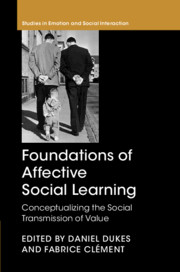Book contents
- Foundations of Affective Social Learning
- Studies in Emotion and Social Interaction
- Foundations of Affective Social Learning
- Copyright page
- Dedication
- Contents
- Figures
- Contributors
- Preface
- A difficult introduction to affective social learning
- Part I On the evolutionary foundations of affective social learning processes
- Part II On human development and affective social learning
- Part III On the mechanics of affective social learning
- Part IV Applications of affective social learning
- Conclusion
- Index
- Studies in Emotion and Social Interation
- References
Conclusion
Laying the foundations of affective social learning
Published online by Cambridge University Press: 09 August 2019
- Foundations of Affective Social Learning
- Studies in Emotion and Social Interaction
- Foundations of Affective Social Learning
- Copyright page
- Dedication
- Contents
- Figures
- Contributors
- Preface
- A difficult introduction to affective social learning
- Part I On the evolutionary foundations of affective social learning processes
- Part II On human development and affective social learning
- Part III On the mechanics of affective social learning
- Part IV Applications of affective social learning
- Conclusion
- Index
- Studies in Emotion and Social Interation
- References
Summary
Affective social learning is a novel concept that aims to conceptualize the transmission of social value. Within the pages of this volume, this simple idea and our presentation of it has already inspired researchers from different disciplines to address what this might mean for their research and for affective science more generally. In this concluding chapter, we restate the motivation for coming up with the concept in the first place, with its origins in psychological and philosophical emotion theory most obviously, but also in anthropology, comparative psychology and sociology. We also insist on the novelty of the concept, undoubtedly due, at least in part, to its multidisciplinary origins. While avoiding the temptation to explicitly answer the points raised by the chapter authors one by one, we address the main points implicitly by either modifying or reformulating aspects of affective social learning before highlighting the points that we think most urgently need to be focused on in future research. While we will of course be continuing our research in this area, we hope that this chapter and indeed this volume more generally will continue to inspire others to join us in this project. In other words, and to paraphrase the title of this volume, we hope to have transmitted the value of affective social learning, socially speaking.
Keywords
- Type
- Chapter
- Information
- Foundations of Affective Social LearningConceptualizing the Social Transmission of Value, pp. 234 - 250Publisher: Cambridge University PressPrint publication year: 2019
References
- 1
- Cited by

